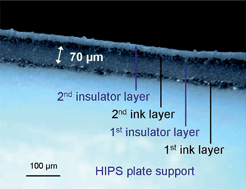Use of screen-printed microelectrodes working as generator/collector systems for the determination of the antioxidant capacity of phenolic compounds
Abstract
A new method using cheap homemade dual-electrodes has been developed to measure the

* Corresponding authors
a Laboratoire Sciences Chimiques de Rennes, UMR-CNRS 6226, ENSCR, Avenue du Général Leclerc, CS 50837, 35708 Rennes Cedex 7, France
b
Université de Pau et des Pays de l'Adour, LCABIE, UMR-CNRS 5254, IPREM, 2 avenue Angot, 64053 Pau Cedex 9, France
E-mail:
laurent.authier@univ-pau.fr
Fax: +33 5 59 40 76 74
Tel: +33 5 59 40 76 65
A new method using cheap homemade dual-electrodes has been developed to measure the

 Please wait while we load your content...
Something went wrong. Try again?
Please wait while we load your content...
Something went wrong. Try again?
A. René, C. Cugnet, D. Hauchard and L. Authier, Analyst, 2013, 138, 2192 DOI: 10.1039/C3AN36212D
To request permission to reproduce material from this article, please go to the Copyright Clearance Center request page.
If you are an author contributing to an RSC publication, you do not need to request permission provided correct acknowledgement is given.
If you are the author of this article, you do not need to request permission to reproduce figures and diagrams provided correct acknowledgement is given. If you want to reproduce the whole article in a third-party publication (excluding your thesis/dissertation for which permission is not required) please go to the Copyright Clearance Center request page.
Read more about how to correctly acknowledge RSC content.
 Fetching data from CrossRef.
Fetching data from CrossRef.
This may take some time to load.
Loading related content
